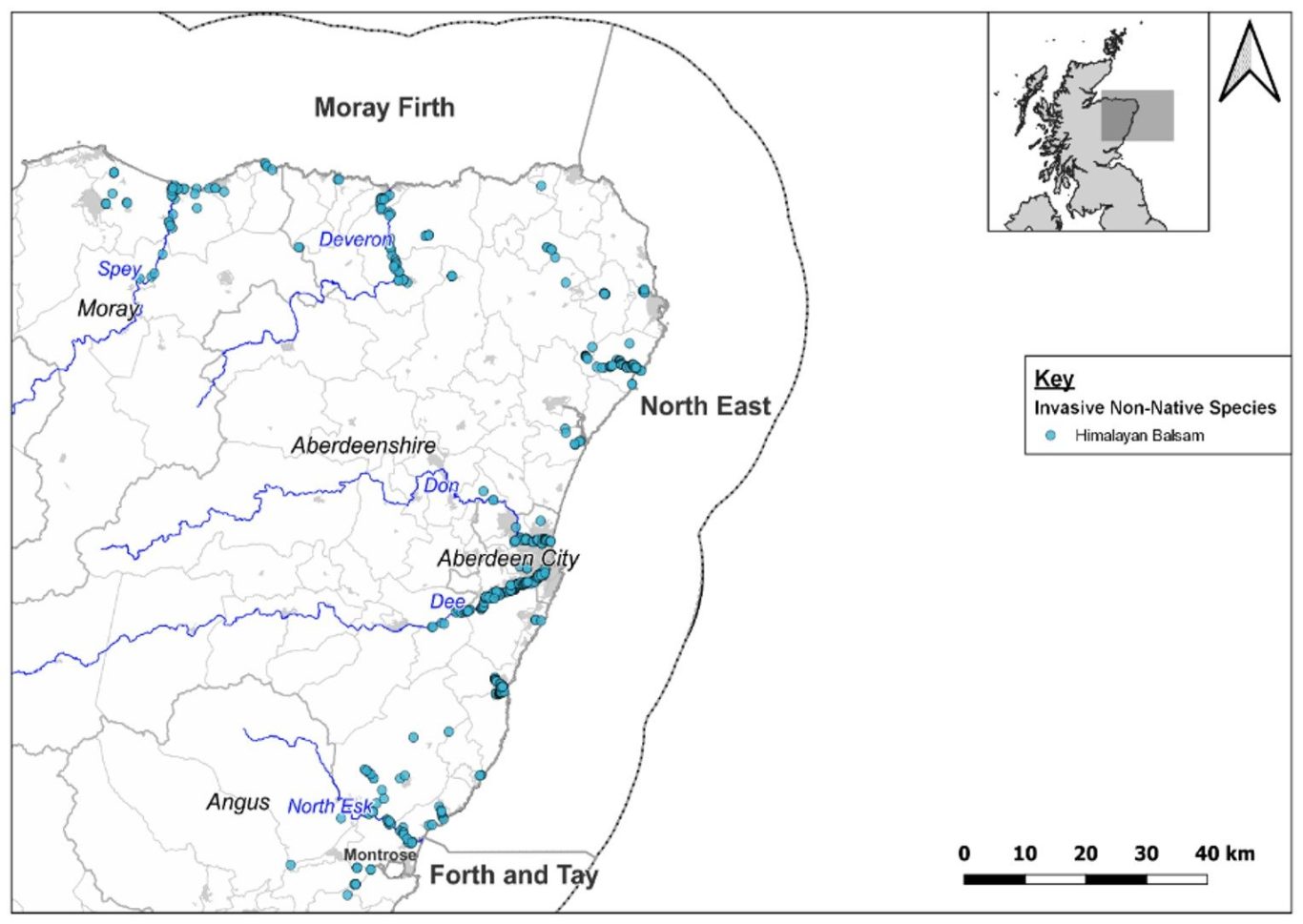Himalayan Balsam - Impatiens glandulifera
Key Findings
While pleasant in appearance (fig. 1), the Himalayan balsam plant is classified as a weed and a pest in many countries. Where present it can wreak havoc on ecosystems and biodiversity, outcompeting native species and damaging the stability of the soil.
Range and Distribution:
Himalayan Balsam is native to the Himalayas, specifically the Western and Southern regions (NNSS, 2019). It was first introduced to the UK in 1839 through intentional planting in Kew Gardens, London. Thereafter, it spread through the UK with himalayan balsam planted in gardens 'escaping', leading to rapid establishment and spread throughout wild areas (NNSS, 2019). The species is found all over the UK (fig. 3.), with its most dense populations in England and Wales. In the Grampian area specifically (fig. 2), the species is commonly found along riverbanks and in urban settlements such as Aberdeen and Cruden Bay. Globally, the species is found throughout much of the Northern Hemisphere, and in parts of the Southern Hemisphere . It is believed that climate change and global warming may allow the species to expand its Northern range. (Pollard, 2017).
Habitat and Physical Characteristics:
Himalayan balsam can grow up to 2m. They can be identified by their purple, ‘policeman’s helmet’ shaped flowers (RHS, n.d.). Himalayan balsam is happiest in damp, slightly shaded conditions and so it is common along rivers, however it can also be found in wasteland and woodland areas (SISI, n.d.). In the UK, the range of Himalayan balsam has been expanding at a rate of 645km2 per year on average, since it first took root in the country (Pollard, 2017).
It is an annual species; each plant produces up to 800 seeds with a high germination rate at 4/5ths (Pollard, 2017; NNSS, 2019). When they are ready, the seeds capsules burst open and propel the seeds up to 7m from the parent plant’s location (SISI, n.d.). These seeds typically stay within the soil until the following spring, although may remain dormant through a full summer season and germinate in the next (NNSS, 2019).
Impacts:
Himalayan balsam can have significant negative impact upon native biodiversity. The high density of seeds produced by each plant makes it good at colonising new areas, dominating and outcompeting native species. It grows in very dense groups and produces high volumes of nectar. Thus, it can prevent other species from receiving light and pollination (SISI, n.d.). The roots of the species are very shallow, and thus offer little support to riverbanks where they commonly grow. When they become dominant, this can reduce the stability of riverbanks and increase the risk of bank erosion and flooding (NNSS, 2019).
Management:
The Wildlife and Natural Environment (Scotland) Act 2011 makes it illegal to plant or allow the spread of any non-native species in Scotland (UK Government, 2011), including Himalayan balsam. Total eradication of the species in the UK has been estimated to cost between £150-300 Million (Pollard, 2017). While not at the scale of total eradication, there are multiple ongoing efforts to manage the Himalayan Balsam population of Scotland. One of the best methods of control is hand pulling - due to their shallow roots the plants are easy to pull from the soil. If the process is conducted for multiple years in a row, this can eradicate the species from a site (SISI, n.d.). As an example, Aberdeen City Council Countryside Rangers hold regular ‘Himalayan Balsam Bashing’ volunteering events. In addition to hand pulling, various other mechanical, chemical and biological methods can be effective. For example, sheep and certain cattle species will graze on Himalayan balsam and so can be used to control the plant in areas where the terrain allows (RAPID, 2017).

fig. 1: A Himalayan Balsam 'policeman's helmet' flower (NNSS ,2019)

fig. 2: NBN Atlas (2024) - Distribution of Himalayan Balsam, records from 1905 -2024

fig. 3: NESBReC (2022) - Distribution of Himalayan Balsam around the East Grampian area 2000-2022
Notes
Linked Information Sheets
Key sources of Information
Reviewed on/by
12/08/2024 by Cathryn Lovie
20/08/2024 by Ian Hay
16/01/2025 by Charlotte Tomlinson (updated)
24/01/2025 by Mariia Topol
Status
First draft
To report errors, highlight new data, or discuss alternative interpretations, please complete the form below and we will aim to respond to you within 28 days
Contact us
Telephone: 07971149117
E-mail: ian.hay@stateofthecoast.scot
We need your consent to load the translations
We use a third-party service to translate the website content that may collect data about your activity. Please review the details in the privacy policy and accept the service to view the translations.

